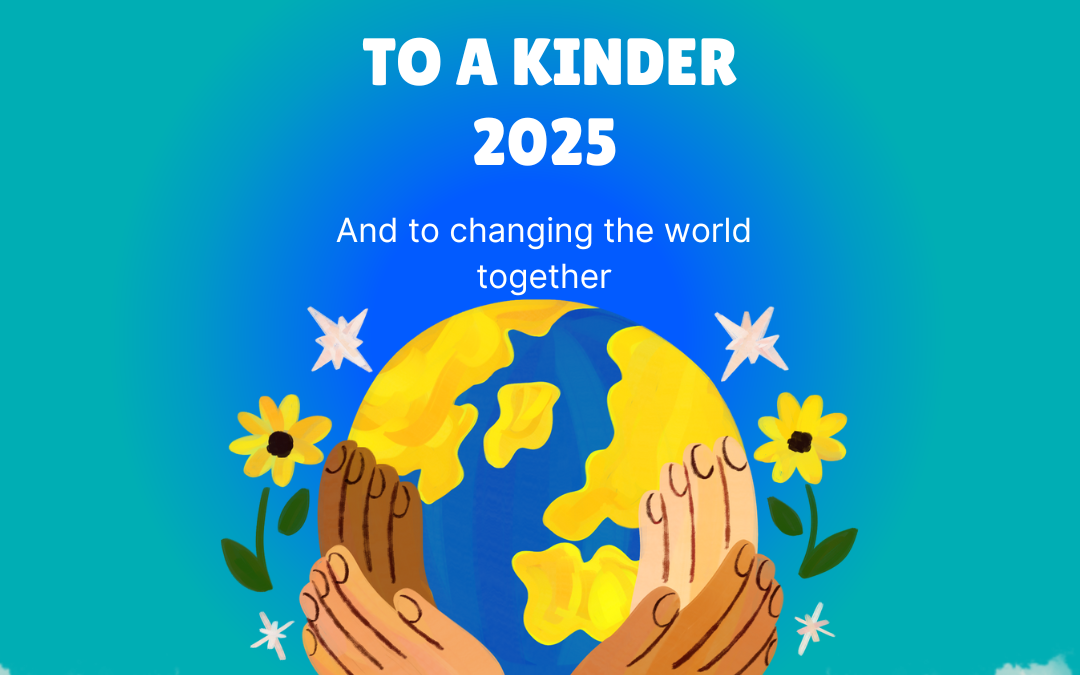We sat down to plan for 2025, and couldn’t help but feel the weight of the unknown. Have you felt this lately? The nonprofit and impact world is changing rapidly, and it’s hard not to wonder: Will your organization be ready for what’s coming?
In 2024, the non-profit sector faced new challenges and opportunities. From digital transformation to the push-back on DEI, the landscape is shifting. The context we are navigating in is also becoming more and more complex and chaotic. This article explores the key trends you need to be aware of and how you can adapt to stay ahead in 2025.
1- Digital transformation and AI integration
The world has seen an unprecedented acceleration in digital adoption over the past few years, and the non-profit sector is no exception. Digital transformation is no longer just a buzzword—it’s a necessity. Nonprofits that embrace this change are finding new ways to connect with their communities, donors, manage resources, and deliver services.
But what does digital transformation really mean for non-profits? It means leveraging technology to streamline operations, enhance donor engagement, and maximize impact. For example, AI-driven tools are being used to analyze donor data, predict giving patterns, and personalize communication. This level of personalization not only improves donor retention but also increases the likelihood of securing larger gifts.
With these opportunities come challenges. Data privacy and security are major concerns, and nonprofits must navigate these issues carefully to maintain trust. Additionally, the rapid pace of technological change can be overwhelming, especially for organizations with limited resources. But the benefits of digital transformation far outweigh the risks, and nonprofits that fail to adapt may find themselves left behind.
CanadaHelps developed this report about digital transformations: How Digital Are Canadian Charities Now? | CanadaHelps
In the digital age, the need for human connections and warmth will also become more entrenched. Nonprofits and their supporters will ask for more personalized, and genuine interactions. Those who will be able to leverage technology and still be authentic (breaking away from the templated formatting and structures of the AI models) will be the ones that stand out, and shine!
2- Bridging divides - Diversity, Equity and Inclusion
Yet, there’s another side to this end-of-year narrative. As much as the season can be stressful, it also ushers in an air of kindness and warmth. The festive spirit softens hearts, which can be a significant boon for nonprofits. It’s a time when people are moved to give not just gifts to loved ones, but also their time and resources to causes they care about.
Generosity peaks in December—proof that people are at their best when dressed in ugly sweaters. It’s the prime time for giving, driven not only by holiday spirit but also the added incentive of year-end tax deductions. Campaigns that tap into this generosity by linking the joy of giving with tangible impacts can see remarkable results.
3- Sustainable funding models
Traditional funding models in the non-profit sector are evolving. As grant funding becomes more competitive and donor expectations shift, organizations are increasingly looking for sustainable ways to finance their missions. In 2025, this trend will be more pronounced than ever. Political and socio-economic changes will disrupt traditional funding sources, and the social impact sector will need to adapt accordingly. They will need to re-adapt their fundraising and programming, to become more intentional about getting flexible, unrestricted funding. Let’s make this THE trend of 2025!

One emerging model is the development of social enterprises, where non-profits create revenue-generating activities that align with their mission. An obvious example is Patagonia, a social enterprise focused on environmental sustainability with a line of eco-friendly products, and profits invested into impact. This approach not only provides a steady stream of income but also enhances the organization’s brand and expands its reach.
Another trend is the rise of impact investing, where investors seek financial returns alongside social or environmental impact. Nonprofits that position themselves as viable investment opportunities can tap into this growing pool of capital, allowing them to scale their impact without relying solely on donations and grants.
Recurring donations are also becoming a key component of sustainable funding strategies. By encouraging donors to make regular, smaller contributions, nonprofits can build a more predictable and stable funding base. This not only helps with cash flow but also fosters deeper donor engagement and loyalty. Nonprofits have the chance to build a brand image, with authentic communication that is “sexy” and that engages around values/mission.
Here comes the dilemma, Nonprofits must balance the pursuit of new income sources with their core mission and values, ensuring that any revenue-generating activities align with their overarching goals. Additionally, developing and managing these new initiatives requires significant time and resources, which can be a stretch for organizations already operating with limited capacity.
4- Increased focus on transparency & accountability
In today’s world, transparency and accountability are more important than ever. Donors, beneficiaries, and the public expect non-profits to be open about how they use resources and the impact they are making. And this expectation will only increase, driven by technological advancements and a growing demand for ethical practices.
By creating immutable records of transactions and activities, in the near future blockchain or other methods and technologies will help organizations build trust with donors and stakeholders. Today’s technology also can allow for real-time tracking of funds, ensuring that donations are used as intended and providing donors with peace of mind.
Transparency is not just about technology. It requires a commitment to ethical practices, clear communication, and regular reporting. Nonprofits must be willing to share both their successes and their challenges, building trust through honesty and openness.
But transparency and accountability are not just about avoiding scandal or satisfying donor requirements—they are essential for building long-term relationships with communities. Nonprofits that prioritize these values are more likely to secure the trust and support they need to achieve their missions.
5- Collaborative networks and partnerships
Collaboration is key to success in the non-profit sector. As challenges become more complex, we see a trend in organizations increasingly forming partnerships to achieve greater impact. We at YAMM Services think that collaborative networks will play a crucial role in the sector’s evolution.This builds on our views around abundance and community, 2 key concepts for success!
By working together, nonprofits can pool resources, share expertise, and reach a wider audience. For example, partnerships between nonprofits and corporations can bring together the strengths of both sectors, creating innovative solutions that neither could achieve alone. These collaborations can also provide non-profits with access to new funding sources, technology, and skills.
Successful collaborations require careful planning and clear communication. Organizations must find partners with shared goals and complementary strengths, ensuring that the partnership is mutually beneficial. It’s also important to establish clear roles and responsibilities, with mechanisms for resolving conflicts and measuring success.
Collaboration isn’t just about achieving short-term goals—it’s about building long-term relationships that can adapt and grow over time. By fostering a culture of collaboration, nonprofits can increase their impact and create lasting change.
6- Emphasis on mental health and well-being
Mental health is becoming a top priority for non-profits in the coming years, not just for the communities they serve but also for their own staff and volunteers. The challenges of the past few years have highlighted the importance of mental well-being, and organizations are recognizing that a healthy, supported team is essential for delivering effective services.
Nonprofits are increasingly implementing mental health initiatives, such as providing access to counseling, creating supportive work environments, and promoting work-life balance. These efforts contribute to preventing burnout, which is becoming more and more prevalent in the non-profit sector.
Supporting the mental health of staff and volunteers also contributes to better impact. A team that feels valued and supported is more likely to be engaged, motivated, and effective in their work. Additionally, nonprofits that prioritize mental health are better positioned to attract and retain talent, which is critical in a sector where resources are often stretched thin.
However, addressing mental health requires more than just offering services—it requires a cultural shift within organizations. Nonprofits must create environments where mental health is openly discussed and where staff feel comfortable seeking help without fear of stigma.
7- The role of youth and emerging leaders
Youth and emerging leaders are playing an increasingly important role in the non-profit sector. Their influence will continue to grow as they bring fresh perspectives, new ideas, and a strong commitment to social justice. Young leaders are driving change by challenging traditional approaches and advocating for more inclusive, innovative solutions. They are also more likely to embrace technology and social media, using these tools to engage with a broader audience and mobilize support for their causes.
Nonprofits that want to stay relevant must actively involve youth in leadership roles, providing them with the opportunities and support they need to thrive. This not only benefits the organization by bringing in new energy and ideas but also helps to develop the next generation of leaders who will carry the sector forward. Moreover, engaging youth as volunteers is equally crucial. Volunteering offers young people a hands-on way to contribute to causes they are passionate about, while also developing their skills and deepening their commitment to the organization’s mission. By creating meaningful volunteer opportunities, nonprofits can cultivate a pipeline of advocates who are deeply invested in their work.
Engaging youth in leadership and volunteer roles requires more than just offering opportunities—it demands creating an inclusive culture that values and respects their contributions. Nonprofits must be willing to listen to young voices, learn from their insights, and support their growth.
Leading the charge into 2025
The future of your organization lies in your hands. By embracing change, you’re not just surviving—you’re paving the way for a more impactful and resilient future. Are you ready to lead the charge?
The coming years present challenges but also opportunities for the non-profit sector. From digital transformation to sustainable funding, transparency, collaboration, mental health, and youth leadership, the trends discussed in this article offer a roadmap for a broader discussion.
As you move forward, remember that adaptation isn’t just an option—it’s essential. Start small, but start today. Whether it’s testing a new fundraising platform, deepening your commitment to DEI practices, or fostering collaborations, acting now will be our path to a brighter common good.
Author Bio
Ali Zaraket brings over 15 years of experience in nonprofit communication, documentary making and journalism to his role as Lead Communication at YAMM Services Inc..
With a background in journalism and commitment to social activism, Ali is deeply passionate about helping nonprofit organizations effectively communicate their mission and engage with key stakeholders.
Throughout his career, Ali has provided communication strategy and training to hundreds of professionals from a wide range of disciplines. When he’s not working with clients, you can find Ali volunteering for local nonprofits, or spending time outdoors with friends and family.

